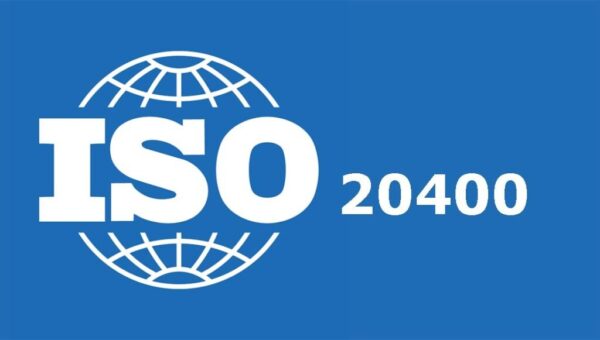Analysis of the status of Green Public Procurement in India highlighting the challenges and making recommendations. There is no reference to ISO 20400 in this report.
Since 2017, ISO 20400 – the international standard for sustainable procurement – has provided organisations with a voluntary framework for embedding sustainability into procurement processes. It has been a valuable resource for those committed to responsible sourcing, but until recently, adoption has largely been driven by leadership vision, stakeholder pressure, or a desire to demonstrate corporate social responsibility.
Now, the landscape is shifting. With the rise of mandatory sustainability reporting, supply chain due diligence laws, and stricter environmental and social governance (ESG) frameworks, the days of voluntary alignment with standards like ISO 20400 are quickly giving way to compulsory obligations.
The question is no longer shouldorganisations adopt sustainable procurement practices – but how fast can they adapt to comply with new legal and market requirements?
In this article, we explore the forces behind this shift, what it means for ISO 20400, and how organisations can prepare for the next stage in sustainable procurement.
The Changing Regulatory Landscape
Across Europe, North America, and Asia, governments are introducing legislation that makes sustainability in procurement less of an option and more of an obligation. The EU Corporate Sustainability Reporting Directive (CSRD), for example, requires thousands of companies to report on their environmental and social impacts in unprecedented detail. Similarly, Germany’s Supply Chain Due Diligence Act holds organisations legally accountable for human rights and environmental risks across their value chains.
These regulations are creating ripple effects well beyond their borders. Suppliers in developing markets, SMEs, and multinational corporations alike are finding that to participate in global supply chains, compliance is becoming a prerequisite.
ISO 20400, originally designed as a guidance tool, is now becoming a critical framework for organisations trying to align with – and demonstrate adherence to – these evolving obligations.
Why the Shift Matters
The transition from voluntary to mandatory sustainable procurement marks a fundamental change in the way organisations operate. It is no longer about demonstrating goodwill or achieving a competitive advantage; it is about meeting baseline requirements for market participation.
Legal AccountabilityOrganisations can now face fines, reputational damage, and even loss of market access if they fail to comply with sustainability laws.
Investor Demands: ESG considerations are no longer niche; institutional investors expect clear evidence of sustainable procurement practices.
Stakeholder Expectations: Employees, communities, and consumers increasingly demand that businesses take responsibility for their supply chains.
The practical implication is that procurement teams must move beyond policies written on paper and ensure that sustainability criteria are embedded into every stage of decision-making.
ISO 20400’s Evolving Role
ISO 20400 was never intended to be a certification standard. Instead, it provides guidelines to help organisations integrate sustainability into procurement processes. In a voluntary environment, this flexibility was a strength, allowing organisations of all sizes and industries to engage at their own pace.
In a mandatory environment, however, ISO 20400 takes on a new significance:
A Reference Point for Compliance: While regulations differ by region, ISO 20400 offers a globally recognised framework that aligns with many emerging legal requirements.
A Bridge Between Policy and Practice: It helps organisations translate high-level ESG commitments into practical procurement actions.
A Tool for Risk Management: By embedding sustainability, organisations reduce exposure to legal, reputational, and operational risks.
Rather than replacing ISO 20400, mandatory rules are cementing its relevance as a foundational tool for organisations seeking to adapt.
Challenges Ahead
The move towards mandatory adoption is not without its hurdles. Many organisations will find the transition challenging:
Complex Supply Chains: Tracing impacts across tiers of suppliers, especially in global contexts, is resource-intensive and often opaque.
Data Gaps: Accurate, comparable, and verifiable sustainability data remains difficult to collect consistently.
Capability Building: Procurement professionals, their peers and suppliers need training, resources, and support to integrate sustainability effectively.
SME Readiness: Small and medium-sized enterprises risk exclusion if compliance requirements become too burdensome.
Without careful implementation, there is a risk of creating a compliance culture focused on “ticking boxes” rather than delivering genuine sustainability outcomes.
Opportunities in the Shift
Despite the challenges, the transition to mandatory sustainable procurement creates significant opportunities:
Driving Systemic Change: By making sustainability a requirement, entire industries are compelled to innovate, improve, and evolve.
Level Playing Field: Mandatory requirements reduce the risk of “greenwashing” and create fairness by holding all market actors to the same standards.
Strengthened Global Collaboration: As more regions adopt due diligence laws, harmonisation across borders becomes both necessary and achievable.
Embedding Long-Term Value:Organisations that take a proactive approach can build resilience, reduce risks, and secure stronger stakeholder trust.
Preparing for What’s Next
So, what should organisations do as voluntary guidance evolves into mandatory expectation?
Conduct a Gap Analysis: Use ISO 20400’s framework to compare current practices against emerging requirements.
Set expectations: Build on a solid ESG policy to set out your expectations from your supply chain.
Prioritise requirements: Build a priority Heat Map by mapping your requirements against your categories of supply
Engage Suppliers Early: Build collaborative relationships that support suppliers in meeting new expectations.
Invest in Training: Equip everybody who participates in procurement decisions or works with suppliers with the knowledge and tools to act effectively.
Build supply chain capacity: Invest in developing capacity, particularly SMEs
Embed good practice: Update procurement processes to ensure requirements are embedded for the long term.
Prioritise Transparency: Develop systems for collecting, verifying, and communicating sustainability data.
Move Beyond Compliance: Treat mandatory standards as a baseline and focus on co-creating genuine positive impact with your suppliers and potentially your “competitors”.
Looking Ahead
The journey of sustainable procurement has entered a new phase. What began as a voluntary movement led by pioneers is becoming a mandatory reality for all. ISO 20400 remains central in this evolution – not as a static standard, but as a living framework that supports organisations in navigating the increasing complexity of global supply chains.
For organisations, the message is clear: voluntary engagement may no longer be enough. The shift towards mandatory sustainable procurement is accelerating, and those who embrace it early will not only avoid compliance pitfalls but also position themselves as leaders in shaping a more responsible global economy.







